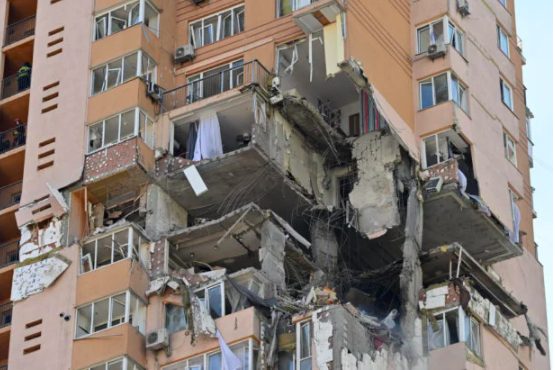Death of a city

A view of a high-rise apartment block which was hit by recent shelling in Kyiv on February 26, 2022. AFP
Ten days into the Russian invasion of Ukraine the casualty count stands as follows: Ukraine military—1,500 killed in action (KIA); civilians—250 dead (these are UN figures); Russia’s defense ministry reports 500 KIA and 1,600 wounded. The highest-ranking figure to die in the conflict is Russian Maj. Gen. Andrey Sukhovetsky, deputy commander of the 41st Combined Arms Army. The circumstances of his death were unclear although some reports indicate that he was killed by a Ukrainian sniper. The advance on the capital Kyiv continues but at a much slower pace indicative of the strength of Ukrainian resistance.
Kyiv is a reminder that 77 years ago around this time, the city of Manila was in its death throes as massed US artillery prepared to pound the last remaining bastions of Japanese resistance in the city. These centered on three buildings—Legislative, Finance, and Agriculture—in the triangular area bounded by Taft Avenue, Burgos, and General Luna. The buildings constructed during the colonial era were built of reinforced concrete able to withstand the strongest earthquake and the Japanese had converted them into individual fortresses with gun emplacements covering all approaches and machine guns within the building guarding the corridors and stairways. Massive and intensive artillery fire followed by infantry accompanied by flame-thrower tanks would leave the Legislative and Agriculture buildings total wrecks. The Finance building would be the last structure in Japanese hands but by March 3, 1945, after devastating bombardment, the building was a pile of rubble. All organized resistance in the city came to an end.
The Battle for Manila that began on Feb. 3, 1945, lasting for 29 days, was the result of absolutely poor military intelligence. In fact, plans were ready for “a great victory parade a la Champs Élysées.” Gen. Douglas MacArthur believed that US forces “could cross the Pasig River and clear all of southern Manila with a platoon.” Although this was hyperbole, the expectation was that only token resistance would be put up by Japanese units still in the city.
After point elements of the First Cavalry Division led by Brig. Gen. William Chase entered the Sto. Tomas internment camp freeing allied POWs, General MacArthur announced to the world that “Manila had fallen.” President Franklin Delano Roosevelt sent a congratulatory message to President Sergio Osmeña, saying “The American people rejoice with me in the liberation of your capital.” Similar messages of praise for MacArthur would come from Churchill, Chiang Kai-shek, and other world leaders. Newsweek magazine’s headline read: “Prize of the Pacific War. Manila fell to MacArthur like Ripened Plum. Invitations were sent by MacArthur to attend his triumphal entry into the city.”
For this event a detailed plan dated Feb. 2, 1945, was issued by GHQ Southwest Pacific Area entitled “Plan for Entry of the Commander-In-Chief and official party into the City of Manila.” The first paragraph read: “The Commander-in-Chief and official party will enter the City of Manila and make a tour of the City along the route of Rizal Avenue–Taft Avenue–Vito Cruz–Dewey Boulevard–around Burnham Green–P. Burgos, to the Legislative Building, arriving thereat for the official ceremony.” In addition, selected troops totaling one division were to be assembled in mass formation prior to the arrival of the commander-in-chief. Arrangements were made for the broadcast and reception coverage in the United States of the ceremony at the Legislative Building (now the National Museum). The orders were signed: “By command of General MacArthur, R.K. Sutherland, Lt. General US Army, Chief-of-Staff.”
There would be no “Champs Élysées” victory parade, no speeches by MacArthur or other officials. The awful truth, contrary to the claim of MacArthur, that Manila had fallen, was that most of the city south of the Pasig was firmly in the hands of Japanese forces under Rear Admiral Sanji Iwabuchi. In the days that followed, Manila suffered a slow and painful death. In his book “American Caesar,” William Manchester wrote “the devastation of Manila was one of the great tragedies of World War II. Of allied cities in those war years, only Warsaw suffered more.“
The casualty count for the Battle for Manila was: 1,010 US KIA, 16,665 Japanese dead, and over 100,000 Manila inhabitants, including women and children, perished. A National Historical Institute marker indicates that those who died “were mainly victims of heinous acts perpetrated by Japanese imperial forces and the heavy artillery barrage of American forces.”
rjfarolan56@gmail.com
Disclaimer: The comments uploaded on this site do not necessarily represent or reflect the views of management and owner of Cebudailynews. We reserve the right to exclude comments that we deem to be inconsistent with our editorial standards.
